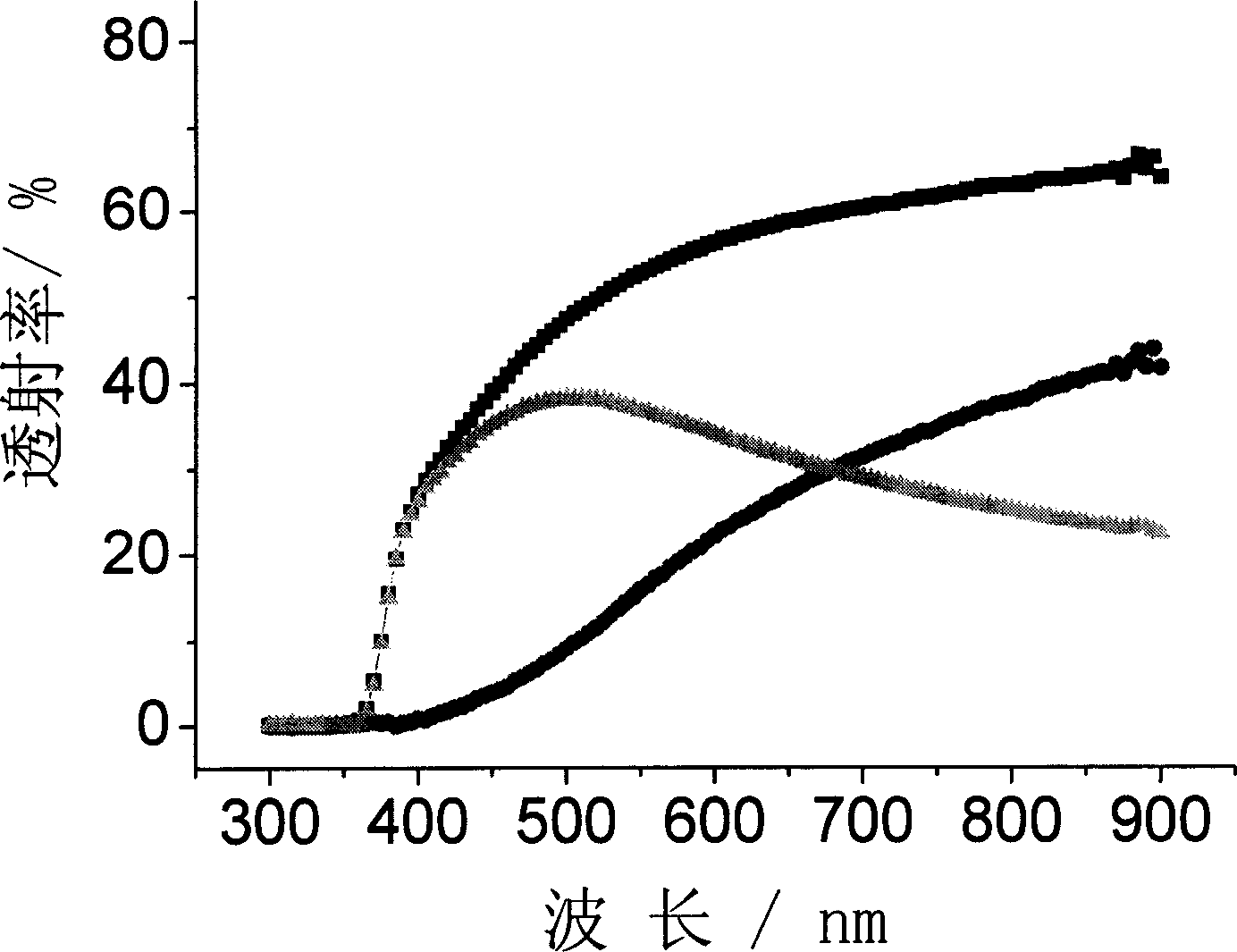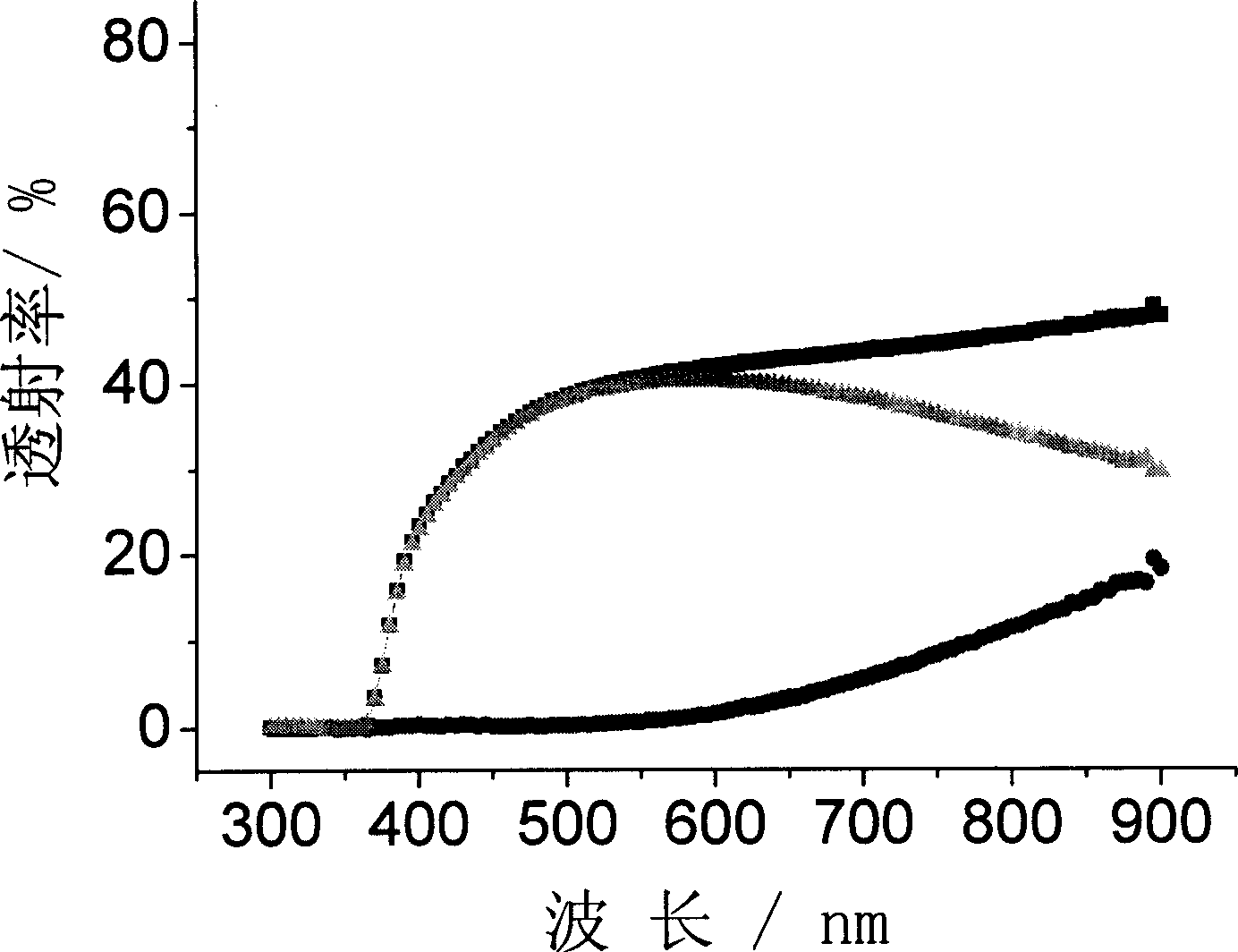Titanium dioxide crystallized light absorption enhancement thin film electrode and its preparation method
A titanium dioxide and thin-film electrode technology, which is applied in the field of TiO2 nanocrystalline thin-film electrodes, can solve the problems of complicated preparation methods, unfavorable industrialization of dye-sensitized solar cells, etc., and achieves simple preparation methods, good overall light transmittance and flatness, and good transparency. Overrate effect
- Summary
- Abstract
- Description
- Claims
- Application Information
AI Technical Summary
Problems solved by technology
Method used
Image
Examples
preparation example Construction
[0062] The preparation method of titanium dioxide nanocrystal light absorption enhanced thin film electrode of the present invention comprises the following steps:
[0063] (1) Clean the surface of the conductive substrate. Use ethanol / acetone mixed solvent to ultrasonically clean the surface of the ITO conductive substrate for 15 minutes, then put it into deionized water with detergent and ultrasonically clean it for 15 minutes, then put it into deionized water and ultrasonically rinse it for 15 minutes three times, then place the conductive substrate in In a clean bench, dry with an infrared lamp.
[0064] (2) Preparation of titanium precursor solution: 3 mL of titanium precursor was dissolved in 100 mL of petroleum ether, and a titanium precursor solution with a concentration of 3% by volume was prepared.
[0065] (3) Preparation of primary semi-finished products of titanium dioxide dense thin film electrodes. The titanium precursor solution in step (2) is evenly coated (...
Embodiment 1
[0087] According to Chinese Science Bulletin, 2005, 50 (18): 1985-1990 and J.Phys.Chem.B, 1997, the method that reports in V.101.55~57 prepares titanium dioxide small particle colloid: prepare the acetic acid (analysis of pH=2) The pure) aqueous solution was kept in an ice bath at a temperature around 0°C. Under vigorous stirring conditions, a mixed solution of 72 mL of titanium isopropoxide (analytical grade) and 72 mL of isopropanol (analytical grade) was added dropwise to 600 mL of acetic acid aqueous solution, and stirred overnight at room temperature to obtain a clear and transparent solution. The solution was vigorously stirred at a constant temperature of 80° C. to evaporate the isopropanol in the solution to obtain a light blue transparent solution. The above light blue transparent solution was placed in a titanium autoclave with a built-in Teflon cup, and heated at 230°C for 12 hours to obtain white TiO 2 precipitation. After the solution is cooled, ultrasonically d...
Embodiment 2
[0092] According to the method in Example 1, except that the polymethyl methacrylate spherical particle size is changed to 300nm, other steps are identical. The first layer of dense TiO 2 The thickness of the film layer is 5 nanometers, which is composed of titanium dioxide particles with a particle size of 2 nanometers; the second layer of macroporous TiO 2 The thickness of the film layer is 4 microns, and it is composed of titanium dioxide particles with a diameter of 25 nanometers and spherical air macropores with a diameter of 300 nanometers.
PUM
| Property | Measurement | Unit |
|---|---|---|
| Particle size | aaaaa | aaaaa |
| Particle size | aaaaa | aaaaa |
| Diameter | aaaaa | aaaaa |
Abstract
Description
Claims
Application Information
 Login to View More
Login to View More - R&D
- Intellectual Property
- Life Sciences
- Materials
- Tech Scout
- Unparalleled Data Quality
- Higher Quality Content
- 60% Fewer Hallucinations
Browse by: Latest US Patents, China's latest patents, Technical Efficacy Thesaurus, Application Domain, Technology Topic, Popular Technical Reports.
© 2025 PatSnap. All rights reserved.Legal|Privacy policy|Modern Slavery Act Transparency Statement|Sitemap|About US| Contact US: help@patsnap.com



